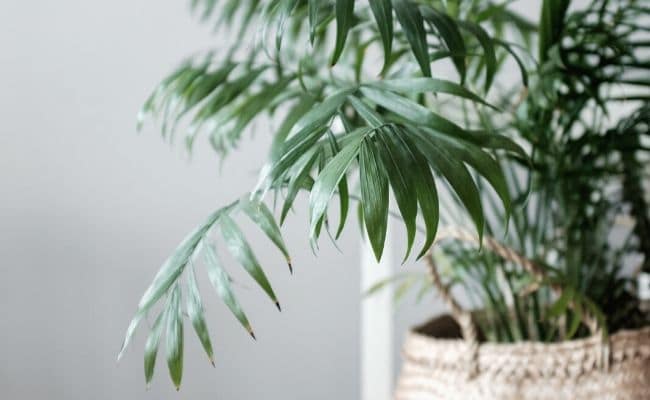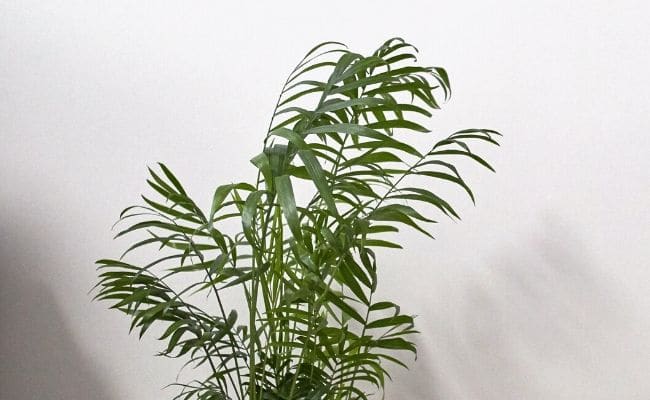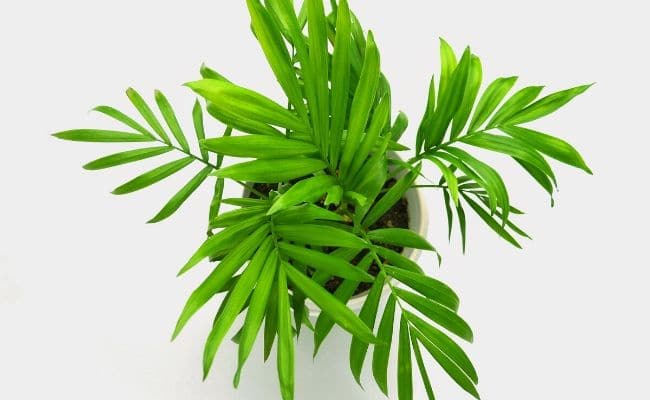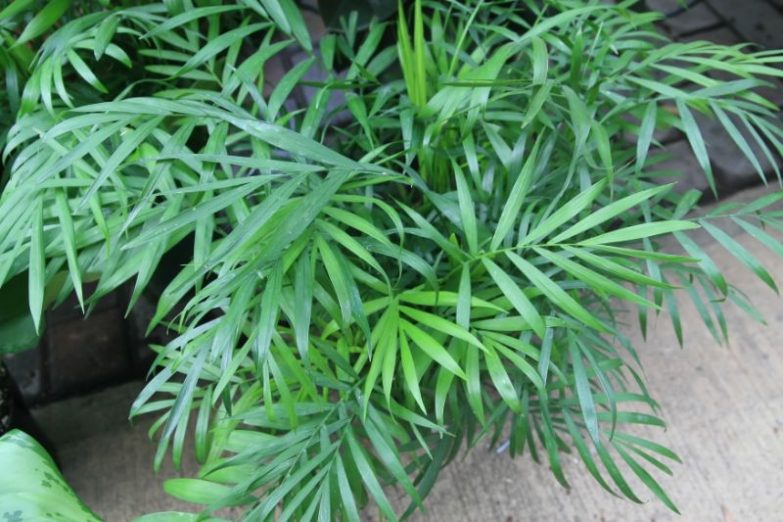Parlor Palms, also called Neanthe Bella Palms, are hugely popular for many good reasons. Their resilience to variable conditions make them suitable for most homes, and their dense, lush fronds exude a tropical vibe. Although generally easy to care for there are a number of common problems. This article is going to help you find out why your Parlor Palm is drooping and show you how to fix it.
Why is my Parlor Palm drooping? Parlor palms (Chamaedorea elegans) most commonly droop or wilt due to overwatering or underwatering. Ensuring you get this aspect of care right will prevent the majority of issues. They can also droop due to temperature stress, transplant shock, excessive fertilizer, or lighting problems.
If you’d like to stop your Parlor Palm drooping, this article will discuss each of the causes, in turn, helping you identify the problem with your plant and get it back to perfect health.
How Can I Tell Why My Parlor Palm Is Drooping?
Many people wrongly assume that a drooping Parlor Palm is due to underwatering, and are quick to reach for the watering can. Whilst this is often the case, if you are wrong, you could do a lot more harm than good to your plant.
Take note of the following before taking any action to fix your plant. Each of these observations will help you to identify the correct cause.
- Are you providing suitable lighting, humidity and temperatures for your Parlor Palm?
- Are there any hot or cold drafts?
- Is the soil dry or soggy?
- Is there an offensive odor from the soil which might indicate root rot.
- Does the pot have drainage holes? (It should have).
- Is the pot appropriately sized for your Parlor Palm. Excessively small or large pots can both cause problems.
- Look at the leaves. Are there any other clues apart from the leaves drooping? Are there brown tips, brown fronds, or curling fronds?
- Can you see any sign of pests? Look at both sides of the fronds carefully.
Once you have gathered this information, it is time to work out why your Parlor Palm is drooping. Lets start with the most common cause and work our way to the least common causes.

Overwatering
Believe it or not, overwatering is a more common cause of your Parlor Palm drooping than underwatering. It is all due to root rot, which is the end result of a persistently overwatered plant. If your Parlor Palm is grown in consistently wet, soggy soil, the roots are starved of oxygen and fall victim to opportunistic infections.
Initially, the foliage of an overwatered plant will start to turn yellow. This often happens from the lower leaves upwards, but will eventually affect the entirety of the plant. As the roots start to die, they are no longer able to provide water to the plant, and the plant starts to experience drought conditions, despite the soil being wet. The fronds of your Parlor Palm will start to wilt, and will look very much like it needs a good drink.
Examine your plant closely, as you will find generally yellow, drooping foliage, without the widespread brown, crispy leaves that might be expected with an underwatered plant. The soil will be wet and you may detect the offensive odor of root rot.
Overwatering is not just caused by watering too often, but by other factors that increase the length of time soil stays wet. Putting a small plant in a large pot, or using poorly draining soil, or a pot without drainage holes can all mean it takes a long time for soil to dry out between watering.
This contributes to the roots of your Parlor Palm sitting in wet, poorly aerated soil for a long time, leading to root rot.
The solution to this problem is to recognize it early and take action fast. You can follow these instructions to fix your overwatered plant, or to treat root rot.
Make sure to plant your Parlor Palm in well draining soil. A mix of 60% peat, 30% perlite and 10% compost is a great option. Choose a pot that is only a few inches wider than the plant, and make sure the pot has plenty of drainage holes.
Underwatering
This problem is a little more straightforward than the last one, and is much easier to identify. Parlor Palms are quite drought resistant, but when the soil gets completely dry, your plant will start to wilt or droop. You will find that the pot will feel quite light, the fronds will be dry and crispy and some may have turned brown.
The simple solution to this problem is to water your plant, and set up a schedule to check on your plant every few days to see if it needs watered. You should make sure that the soil is sufficiently water retentive and that the plant has not become very rootbound. A highly rootbound plant will typically use all the water it is given quite quickly.
Bear in mind that the time of year will have a big impact on how likely it is your Parlor Palm is drooping due to lack of water. In spring and summer, water requirements will be much higher, as the plant will be growing strongly, and the combination of higher light and temperatures will result in water being used far quicker.
Always remember to avoid watering on a schedule. Just check your Parlor Palm every few days and water once the top 1-2 inches of soil are dry. Water your Parlor Palm thoroughly every time, allowing water to drain freely out of the drainage holes. Ensure that all excess water has drained from the pot before replacing your Parlor Palm in its normal spot. See my guide to watering houseplants for more information.

Temperature Stress
Parlor Palms normally grow best between 65°F (18°C) and 80°F (27°C), but can cope with temperatures outside of this down to 50°F (10°C). Below this, your plant will start to suffer stress, and the roots can struggle to function properly. Even though you may be providing otherwise perfect conditions, if the roots cannot function, this can lead to your Parlor Palm drooping.
Your home will likely provide reasonable temperatures for your Parlor Palm, but be aware of vents and drafty windows, which may impact the health of your plant. If in doubt, place a digital thermometer beside your plant, ideally one that records the maximum and minimum daily temperatures and ensure this falls within a recommended limits.
Also, be careful if you take your Parlor Palm outside for summer. This can be very beneficial for your plant, but if you are slow to bring your Parlor Palm indoors as the cold nights of fall arrive, then your plant may be exposed to temperatures well below 50°F (10°C). They are not cold hardy, and persistent cold temperatures can lead to your Parlor Palm drooping or worse.
Transplant Shock
Repotting is one of the most stressful times for your Parlor Palm, and care is needed to ensure the roots are not damaged. Nevertheless, even if you take great care, it can take a few weeks for your Parlor Palm to adjust to its new home. Sometimes your Parlor Palm will droop, other times it may develop some brown tips, or just stop growing for a while.
If you have recently repotted your Palm, make sure to provide optimal conditions to help your plant to recover. Avoid excessive light and allow the soil to dry out a little more than normal for the first few weeks after repotting. See this article to read more about how to repot your houseplants correctly.
Lighting Problems
Lighting problems can result in your Parlor Palm drooping, but it usually happens in conjunction with another problem.
Insufficient light results in slower growth and stunted, small leaves. The fronds will often become darker green initially, as the plant tries to produce more chlorophyll and arrange it most efficiently in the leaves.
Eventually, the plant cannot maintain all of its foliage in poor light conditions, and some of the foliage, typically lower, older foliage starts to turn yellow and die, and you may find your Parlor Palm drooping and looking rather sad.
Poor light can also result in symptoms of overwatering, as the water requirements of your Parlor Palm will be greatly reduced in poor lighting. Parlor Palms do best in bright, indirect light. This is usually brighter than most people imagine, so read this article for more information.
If your Parlor Palm is showing signs of poor lighting, move it closer to a window. Even 1-2 hours of direct sunlight per day will be ok. Just avoid placing your Parlor Palm in a location where it gets more direct sunlight than this.

Excessive Fertilizer
If your Parlor Palm is drooping due to excess fertilizer, you should be able to work this out fairly quickly. Look for salt crusts/deposits in the soil and for brown leaf tips. Think how often and how much fertilizer you have been giving your plant.
I usually recommend fertilizing Parlor Palms about once per month during the growing season. However, it very much depends on what type of fertilizer you are using. I like to use a general-purpose, water-soluble, balanced fertilizer. I make this up in water at half the strength recommended for outdoor plants and apply once per month.
Organic fertilizers are another great option for providing longer-acting nutrients to your plants, and they usually reduce the risk of overfertilizing. Just remember that fertilizers are needed to prevent nutrient deficiency in your plants, and adding more will not make your plant healthier or grow faster. Read my guide to fertilizing houseplants for more information.
Excessive nutrients in the soil of your plants will eventually lead to root toxicity and reduced root function, resulting in your Parlor Palm drooping.
If you think you have been fertilizing your Parlor Palm too much, flush the soil with plenty of water to help remove the excess salts from the soil. Take your plant to the sink and run water through the soil for 5 minutes. Let the plant drain thoroughly after this before returning it to its normal spot. I normally flush my Parlor Palm twice per year as part of its general care to prevent any salt build-up.
Last Word
Hopefully, this article has helped you find out why your Parlor Palm is drooping, and your plant will be on the road to recovery very soon. As with so many houseplant problems, examining your plant closely will often lead to the answer to the problem.
This is the approach I take with all my plants and it often helps me detect problems before they negatively impact my plants. If you’d like to easily understand what your houseplants need and detect problems early, check out my book, Houseplants Made Easy. I cover everything you need to know to have more confidence, enjoyment and success in growing houseplants.

